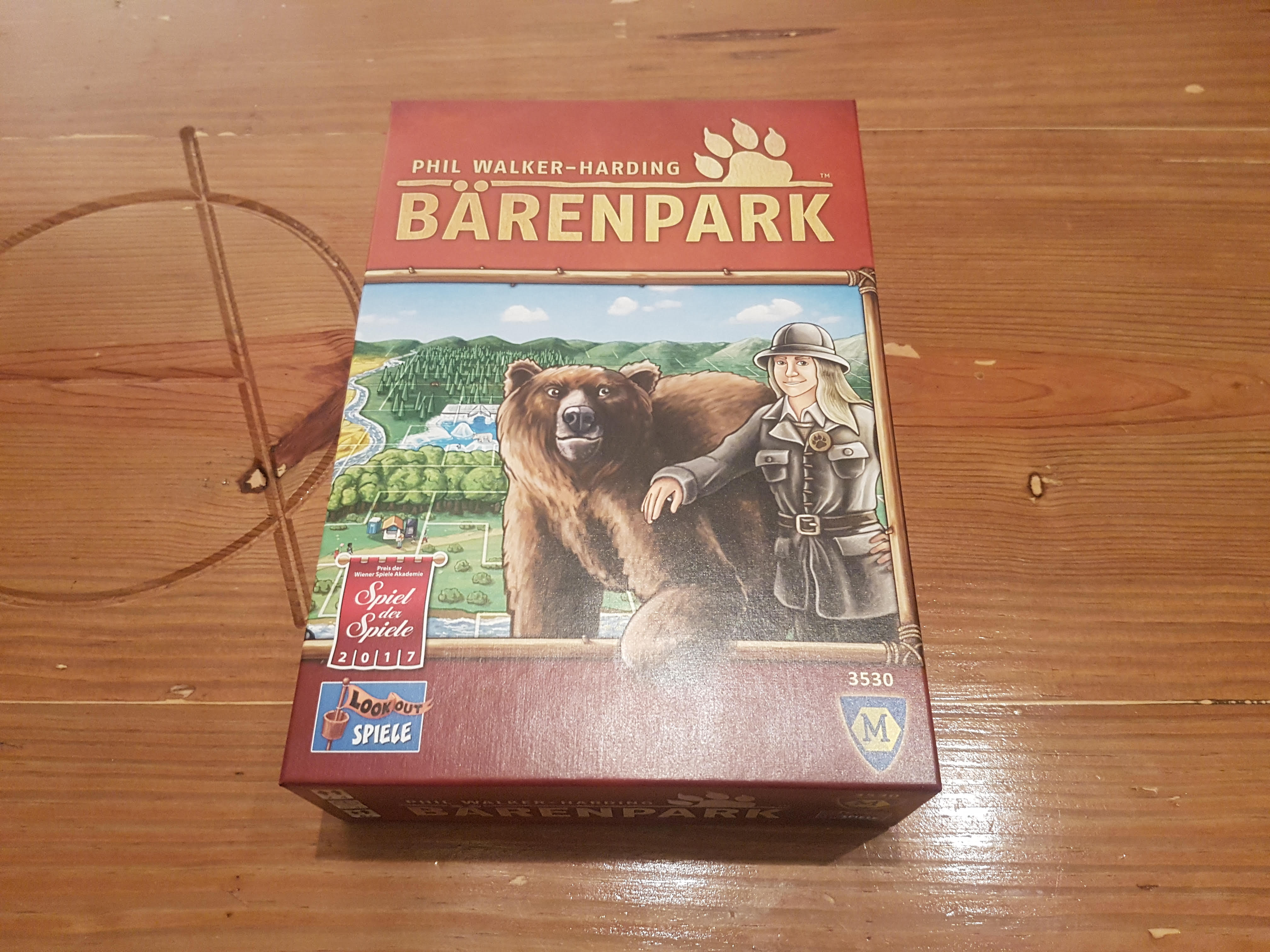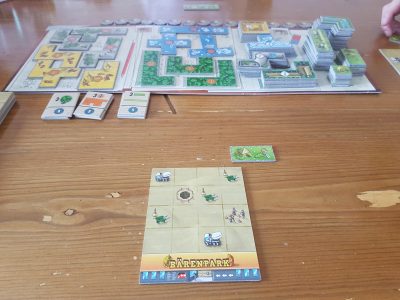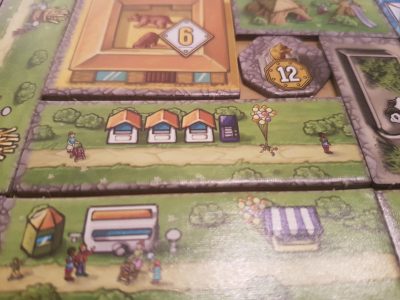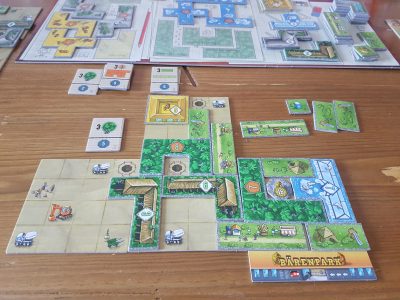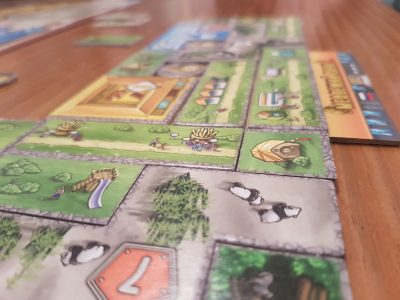Bärenpark is a tile placement board game, with hints of set collection, released in 2017 by Lookout Games and Mayfair Games. Designed by Phil Walker-Harding, Bärenpark is for 2 – 4 players and takes between 30 – 45 minutes depending on the player count and experience. Players take up the roles of park owners as they look to fully fill their plots of land with park attractions, including bear enclosures and food stalls. However, there have been other very similar games released in the last couple of years. So, is Bärenpark worth playing, let alone picking up? Let’s find out!
Players start off with a park entrance board and depending on where they sit in the turn order a specific starting piece. On a turn a player works with way through 3 or 4 phases depending on the variant of play, normal or expert respectively. Starting off, a player places a single Tetris block like polyomino tile from their hand onto their park board. It must (unless being the first tile) orthogonally touch an already placed tile, fit in its entirety onto the board space available and it cannot cover the special Pit space.
Where on the board the tile is placed is important as covering an icon rewards the player with new tile. Failing to cover a single icon will effectively waste a future turn to pick up a tile. Tiles are broken down into three distinct types (denoted by): green areas (a wheelbarrow), animal housing (a cement mixer) and enclosures (an orange excavator). Covering one of these icons allows that tile type, or below, to be claimed. The green areas do not score points, but can be helpful for filling in gaps on your park board. Animal housing tiles have piles of identically shaped tiles which score points denoted on the tiles, with the value decreasing each time a tile is taken. These are the staple of player scoring and feature all four of the different bear types.
Lastly, are enclosures, which are all uniquely shaped, cover more spaces than the other types and mostly score more points. These are three of the icons with the final one players can cover being a construction crew. This enables the player to take the top most park tile, from either of the two piles, and instantly use it to expand their park, until a total of 4 park boards are connected. After this phase is complete and the player gets to choose pieces based on the covered icons and then it is time for statues. If every space on a board, apart from the Pit, is covered the player claims the highest values Bear Statue and adds it to that board to cover the Pit.
If a player has finished their fourth board, claiming a fourth and final bear statue, each other player would get one final turn. This concludes the game and scoring commences. However, if you play the expect variant another phase slots in before the next players turn. This variant adds in achievements which, as an example, could be to have 3 Panda tiles in your park. After checking to see if you should get a bear statue, players must check to see if they have fulfilled any of the three objectives, taking the top achievement tile of that type if they have. These score more points the earlier you claim them so can swing the game in your favour.
Bärenpark has unfortunately done little to get away from the maths and counting based scoring system employed by most tile placement, puzzle games. Players must add up all the points on the tiles on their park board and any achievement tokens they have earnt. As usual with this system, most people get their phone out to do the sums on a calculator app. It’s a disjointed experience, far from the fun of constructing a park and makes the end of a game a little tedious. After the enjoyment of building players must wait to find out the winner, rather than it being quick and enabling them to just reset the game and dive back in for more entertainment.
Before mentioning my thoughts on the theming, it would be best to briefly address the elephant in the room, or in this case the Koala in the game. Bärenpark translates as bear park, yet the tiles feature Bears, Koalas, Polar Bears and Pandas. Koalas are often referred to as koala bears but are in fact marsupials. Look past this oversight though and you are in for a treat, though I’m sure some will be oddly annoyed by this oversight.
From a mere glance the artwork on the tiles is pleasant and colourful. The tiles are hard to fault, as they do a superb job at creating the visual look of a zoo or animal park styled map. It’s only after you look closely at the small details that the illustrations are truly appreciated though. From port-a-loo style toilet blocks to the small child floating away via the balloons they are clutching the small details capture the light hearted fun nature of Bärenpark perfectly. The illustrations are repeated, so not every tile is unique. Thankfully though, there is enough variety that you’ll often not notice and even if you do it doesn’t heavily detract from the game’s visual appeal.
The placement of tile to gain new tiles is an easy to understand concept that negates the need for any in game currency. Having that extra layer of tokens in other tile placement games adds an unnecessary layer of fiddly-ness and at times complexity. It means players won’t have to worry about claiming and passing back and forth currency every turn. Having that instant reward of a specific type of tile in return streamlines the gaining tiles process, and gets you more engrossed in the building side of the puzzle.
Bärenpark at its core is a simple game but it has layers that add to the puzzle. As players experience grows, while the gameplay stays the same, players attitudes to how best to score points changes. Players must wean themselves away from just placing tiles to get fancy looking shapes and start solving the puzzle via the most optimal moves. There are also achievements which the game considers an expert variant. For most, even those whom are new to the Bärenpark and/or new to the hobby, I’d include these from the start. Achievements, with their additional ways to score points, shake the puzzle up slightly each time you play, making different sets of tiles more sort after.
As the core objective of completing all four boards remains consistent no matter what, everyone can at least put up some kind of competition. This is integral for those new to the hobby not to be put off by being destroyed points-wise. Also, being Zoo themed attracts players in, engaging them from the start. It takes around a couple of minutes to explain the game from how to play through to scoring. This speed is helpful as it means you can explain while doing the slightly length setup.
Setup is a bit of a stumbling block for Bärenpark, and is an issue that unusually decreases as the player count increases. In a full 4 player game all of the many included plastic bags are emptied, every tile is in play and simply ordered lowest to highest in terms of the point value. As soon as the player count drops, specific tiles must be removed from most of the piles making it more tedious and time consuming. Tear down can also take a bit of time, sorting all the tile types into their own bags. On the flip side this then speeds up the setup of the next game, so is a worthwhile expense of time. If you’re having to set the game up beforehand, without help, then it can be annoying but if everyone round the table jumps in to help then the time impact is lessened.
Bärenpark is thankfully less cutthroat than Patchwork even when played as a 2-player game. One reason behind this is the opportunity to obtain the same shapes. For the lower two categories of tiles, green wheelbarrows and white cement mixers, there are multiple of each tile, though they do decrease in point value. This means until the pile has been exhausted even if someone else has taken the shape of piece you need there is another waiting for you to take. The top tier of tiles, orange excavators, are unique so there is an element of getting the ones you need fast, though overall the game have less of a take that feel.
For the most part there is very little reason to lift your head out of your own player board and this is mostly due to almost non-existent player interaction. Towards the middle and end of the game players can determine pieces others need and take them first but they are then stuck with those pieces instead of taking what was most optimal for their own park. There is a bit of a race element between player to completing the objectives as doing one first nets more points. This being said, often when you notice an opponent going for one objective, unless you are close to also completing it, you simply aim to complete a different one first.
Having spent many hours on end with my eyes stuck on a Gameboy screen playing Tetris having an almost solitaire feel to the game is not an issue, and the use of the shapes in the puzzle hits the nostalgic nerve perfectly. Some gamers will despise such a game with no real ways to benefit from player interaction but for those of us whom enjoy solving a puzzle Bärenpark scratches the itch as well as any other game. The gameplay is extremely similar to other games out there, like the mentioned Patchwork, and it even takes a while to setup and tear down. However, it is the non-tedious, fun family friendly visual appeal that stands Bärenpark above the rest: inviting people in, whether they are gamers or non-gamers alike.
[Editor’s Note: Bärenpark was provided to us by Asmodee UK for review purposes. The game is currently available on 365 Games for £32.99. It is also available from local UK board game stores, find your local store here]

